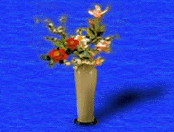
![]()


![]()

As a people, the Chinese believe in the basic oneness of man with the universe. They consider flowers living creatures, each with its individual personality and significance. Consequently, they are very particular about the varieties of flowers that they select for floral compositions. As Yuan Hung-tao of the Ming Dynasty fame put it in the History of the Vase: "Although flowers are found everywhere, one must be careful about the types he chooses, preferring bamboo and pine to merely a random selection from the vast kingdom of plants. Each flower has its own distinct character and personality, and a flower arranger would no more indiscriminately choose one for his composition than he would invite an absolute stranger he met at the marketplace into his home."
Generally speaking, three characteristics were taken into account when selecing plants for flower arrangements:
1 .) The name of the flower. In this connection the peony, or "flower of wealth and honor," and narcissus, or "water-borne immortal," were considered good choices because of their obviously auspicious connotations. As for the rhododendron, or shih nan, the pronunciation of the first character in its Chinese name was uncomfortably close to that of szu, the character for "death." This flower, consequently, was to be strictly avoided.
2 .) Special attributes or characteristics. Since the cypress and pine remained "ever green," and the orchid was often compared to a lovely woman, these plants also ranked high on the list of candidates for selection. On the other hand rattan (or other climbing plants), given its penchant to twist, curl, and tangle, and wild flowers and weeds, noted for their short lives, were considered taboo.
3 .) Associated, myths and legends. One example is the Jui hsiang, said to have obtained its name when a monk first smelled its fragrance during a dream. As a result, it enjoys a reputation of honor and nobility. The Lady Yu flower, on the contrary, since it was believed to be the ill-fated wife of Duke Hsiang Yu in reincarnated form, was regarded an unlucky flower and was shunned.
Among the "good plants" considered suitable for flower arranging were the pine, cypress, bamboo, mei blossoms, osmanthus, orchid, chrysanthemum, peony, plum flower, narcissus, camellia, calamus, pomegranate, bergamot, and ling chih fungus. The peach flower might be considered in either the good or the bad category, depending on various circumstances. As for the poppy, aster, rhododendron, cockscomb, the Lady Yu flower, and weeds and wild flowers, these were always shunned for purposes of flower arrangement. A more detailed explanation of the do's and don'ts of flower selection can be found in the Miscellanies from the Triple Willow Pavillion and similar books.
![]()
[preface] [
styles] [religious] [palace]
[literati] [folk]
[9 pricniples] [significance] [preveration]
[vessels] [appreciatin]
[Pavilion of Taiwan,
R.O.c] [Cultures]
[Council For Cultural
Affairs]